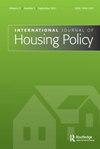重新定义住房的空性,超越空置和废弃
IF 2.6
2区 经济学
Q3 ENVIRONMENTAL STUDIES
引用次数: 1
摘要
学术对建筑空性的不同表现形式的反思是广泛的,它与近60年来关于城市问题的各种争论相交叉。尽管如此,建筑空性的概念及其细微差别还没有完全令人满意。定义是模糊的,不同的现象往往是混合的。正是在这种背景下,经过简短的最新技术审查,本文提出了住房资产空化的主要状态的精确概念化。确定了四个关键条件:i)未完成性,即建筑物在施工阶段未完成的状态;Ii)长期空置,即由于建筑物正常使用年限以外的任何原因,物业在房地产市场上停留较长时间的状态;Iii)闲置,即成品物业不能出售或出租,偶尔使用(闲置)或不作任何住宅用途(闲置)的情况;(四)废弃,即长期无人居住和维护的空置建筑物的状态,由于其物理老化而与住房市场分离。随后,就描述性和规范性问题强调了这种概念化的含义。例如,这种概念化可以帮助更好地理解不同状态的住房空置的负面外部性,以及它可以支持更仔细的道德判断。本文章由计算机程序翻译,如有差异,请以英文原文为准。
Reconceptualising housing emptiness beyond vacancy and abandonment
Abstract The academic reflection on different manifestations of building emptiness is broad, intersecting the last sixty years of various debates on urban issues. Despite this, the conceptualisation of building emptiness and its nuances is not yet completely satisfactory. Definitions are blurred and different phenomena are often mixed. It is against this backdrop that, after a short state-of-the-art review, this paper proposes a precise conceptualisation of the main states of emptiness of housing assets. Four critical conditions are identified: i) uncompletedness, that is the condition of a building which, during the construction phase, is left unfinished; ii) long-term vacancy, that is the state of a property which remains on the real estate market for a prolonged period of time, for any reason other than the conventional circumstances of the ordinary life of a building; iii) under- and unoccupancy, which are conditions of finished properties that are not available for sale or rent and are either used occasionally (under-occupancy) or not put to any residential use (unoccupancy); iv) abandonment, that is the state of an empty building which has not been inhabited and maintained for a long time, thus being detached from the housing market due to its physical decay. Subsequently, the implications of such conceptualisation are stressed, with reference to both descriptive and normative issues. For instance, this conceptualisation could help a finer understanding of the negative externalities of different states of housing emptiness, as well as it could favour more careful ethical judgements.
求助全文
通过发布文献求助,成功后即可免费获取论文全文。
去求助
来源期刊

International Journal of Housing Policy
Multiple-
CiteScore
5.80
自引率
14.30%
发文量
42
期刊介绍:
The International Journal of Housing Policy aims to be the leading forum for the critical analysis of housing policy, systems and practice from a social science perspective. It is published quartely. We welcome articles based on policy-relevant research and analysis focused on all parts of the world. We especially encourage papers that contribute to comparative housing analysis, but articles on national or sub-national housing systems are also welcome if they contain data, arguments or policy implications that are relevant to an international audience.
 求助内容:
求助内容: 应助结果提醒方式:
应助结果提醒方式:


